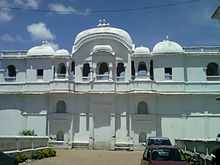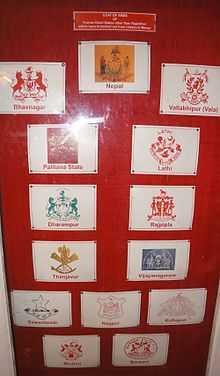Pusapati
Pusapati or Poosapati was the ruling clan of the Kalinga Vizianagaram (founded in late 16th century AD). They were Kshatriyas of the Suryavanshi sect.
History


The Paricchedi Kings were ancestors of the Pusapati royal family who built Bezawada (Modern Vijayawada) off the river Krishna by 626 AD and another capital in Kollipaka establishing themselves for nine centuries there.[1] They were staunch patrons of Hindu Dharma in contrast to the Chalukyas, who initially were patrons of Jainism.[2]
The family name was changed to Pusapati after moving to the coastal region. The name is derived from the Sanskrit Pushavat (Pushan), meaning of the sun, to highlight their Suryavanshi lineage. They founded the city of Vizianagaram, named after Vijay Rama Raju, spelled with a Z to differentiate it from the Vijayanagar Dynasty in Hampi. They obtained the title of Gajapathi, after the battle of Nandapur, in the Northern Circars in the 16th century.
The Maharaja of Vizianagaram is stated to be descended from the Ranas of Udaipur,[3] the Sisodia branch of the Guhilot tribe and Vasishta gotra. According to the traditions of the Udaipur house, a member settled in Ayodhya (Oudh) and in the 6th century AD emigrated to Telingana, accompanied by representatives of the Vasishta, Dhanunjaya, Kaundinya and Kasyapa gotras. In 1484 Pusapati Rachi Raju wrote Vasistha Gotra Kshatriya Sisa Malika. [4]
The Rajas allied themselves with the Gajapathi Emperor of Orissa against the Vijayanagar Empire initially but after being conquered by Krishna Deva Raya they became their feudal allies. They, along with the other allies of Vijayanagar were conquered by Sultan Kali, the founder of the Qutub Shahi dynasty of Golkonda but by 1652 the 5th king of the subsequent Pusapati line was made Subahdar of the Northern Circars and they re-established themselves in the Vizagapatnam country. Emperor Aurangzeb has given them a two-edged sword (Zulfiqar), which is still used in the coat-of-arms of the family. [5] By 1713 they erected the fort at Vizianagaram where they have since resided. In 1827 Maharajah Vijay Rama Gajapati Raju III[6] had several honors conferred on him by the British Government. Lord Northbrook obtained for him the title of His Highness, and had his name enrolled among those of chiefs entitled to return visits from the Viceroy with a 13 gun salute.
Pusapati rulers

- Up to 1509 A.D. The Pusapatis were ruling in Vijayawada, Their ancestors used the family name of Bezawada, as that is what Vijayawada was called at the time.[3]
- Pusapati Rachi Raju (1515 A.D.)[4][5] He was an ally of the Gajapathi King Rudra Deva, they were both defeated by the Vijayanagar Emperor Krishna Deva Raya. After his defeat, Krishna Deva Raya reinstated him and He and Rachi Raju married the daughters of Rudra Deva.
- Pusapati Amala Raju (Founder)
- Pusapati Tama Bhupaludu (1620–1670)
- Pusapati Sita Rama Chandra Raju (ruled 1685–1697) In 1687 A.D. when Mughal emperor Aurangzeb conquered Golkonda, Sita Rama Chandra Raju obtained the Zulfikar (Two edged sword) that figures on the Pusapati flag from the emperor as a token of appreciation for having assisted him in his campaign.[6]
- Pusapati Peda Vijaya Rama Raju (ruled 1710 – died 1757) (Founder of Vizianagaram, moved the capital from Potnur) Died in the battle of Bobbili
- Pasupati Ananda Raju (died 1760) Captured Vishakapatnam and Rajamundry[7]
- Pusapati Chinna Vijaya Rama Raju (1760–1794) Died in the battle of Padmanabham against the British. Vijaya Rama Raju's brother Sita Rama Raju attacked Parlakamedi along with their Maratha allies and conquered it.
- Pusapati Narayana Babu Raju (1794–1845)
- Pusapati Vijaya Rama Gajapati Raju (1845–1879)
- Pusapati Ananda Gajapati Raju (1850–1897)
- Pusapati Vijaya Rama Gajapati Raju (1897–1922)
- Pusapati Alaka Narayana Gajapati Raju (1922–1937)
- Pusapati Vijaya Rama Gajapati Raju (1924–1995)
- Pusapati Ananda Gajapati Raju (1950-)
- Pusapati Ashok Gajapati Raju (1951-)
Gajapati literally means Lord of elephants
Recent famous people of Pusapati
- Poosapati S Kumaraswamy Raja - Former Chief Minister of Madras Presidency (Tamil Nadu) (1949–52) and Governor of Orissa (1954–56).[8][9]
- Sir Pusapati Vijayananda Gajapathi Raju also known as Maharajkumar of Vizianagram or Vizzy - Former Indian cricketer, Cricket administrator and Politician.
- poosapati manikanta raju
See also
- Rajus
- Raju Zamindaris
- Kshatriyas
- Pericchedi
- Chagi
- Kota Vamsa
- Pusapatirega
References
- ↑ A History of Telugu Literature p. 36
- ↑ Mediaeval Jainism: With Special Reference to the Vijayanagara Empire by Bhasker Anand Saletore
- ↑ No. 45. (A.R. No. 491 of 1906.) Pulivendla, Pulivendla Taluk, Cuddapah District. On a slab set up at the entrance of the Ranganathasvamin temple. Krishnaraya, AD 1509. This is dated Saka 1431, Sukla, Kartika su. 12, corresponding to AD 1509, October 24, which was, Wednesday. It records a gift of the village Kunddal Kundu to the god Sri Ranga Raju of Pulivindla by Narasayya Deva Maharaju, brother of Basava Raju, son of Tamma Raju, grandson of Valla Bharaya and great-grandson of Bejawada Madhava Varma of Vasishtha-gotra and Surya-vamsa. The gift village is said to be situated in Pulivindalasthala, a subdivision of Mulkinadu in Gandhi Kotasima of Udayagiri Rajya.
- ↑ Vizianagaram Zamindars
- ↑ No. 52. (A.R. No. 18 of 1915.) Srisailam, Nandikotkur Taluk, Kurnool District. On stones built into the floor of the platform in the eastern porch of the Mallikarjuna temple. Krishnaraya, AD 1515. This is dated Saka 1438 (current), Yuva, Sravana su. 15, Wednesday, lunar eclipse, corresponding regularly to 25 July 1515. The king, it is stated, started out from Vijayanagara on a campaign of conquest towards the east, conquered at a stretch Udayagiri, Addanki, Vinukonda, Bellamkonda, Nagarjunikonda, Tangedu, Ketavaram and other hill-forts and land-forts and captured Tirumala Kataraya Mahapatra. Having taken Kondavidu, he captured alive Virabhadra Raya, Nara Hari Deva, Rachuri Mallukhanu, Uddandakhanu, Jannala Kasavapatra, Pusapati Rachiraju, Srinatha Raju, Lakshmipati Raju, Paschima Balachandra Mahapatra and others. Later he reinstated the captives in their places, visited Amaresvara at Dharanikota and performed the Tulapurusha ceremony in the presence of the god on the banks of the river Krishnaveni. He had the Ratnadhenu and Sapta Sagara Mahadanas performed by his queens Chinna Devi and Tirumala Devi respectively. Finally he visited Sriparvata, where he had the mandapa built in the car street of the temple.
- ↑ Andhra Pradesh (India) (2000). Andhra Pradesh District Gazetteers: Vizianagram. Director of Print. and Stationery at the Government Secretariat Press; [copies can be from: Government Publication Bureau, Andhra Pradesh]. Retrieved 2014-11-19.
- ↑ Francis, W. (2002). Gazetteer of South India (v. 1-2). Mittal Publications. p. 254. Retrieved 2014-11-19.
- ↑ Rajapalayam History
- ↑ Virudhunagar Official Weblink